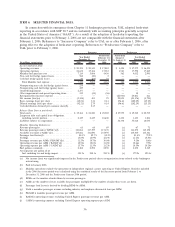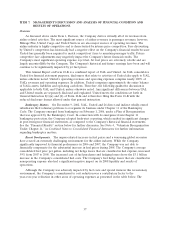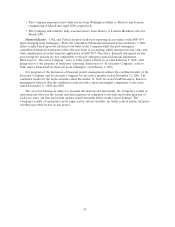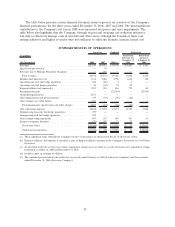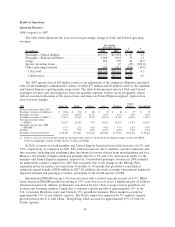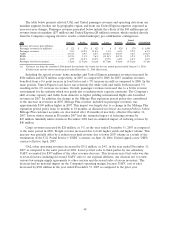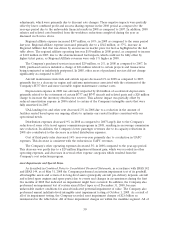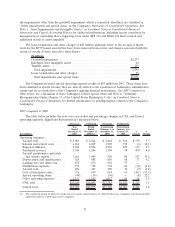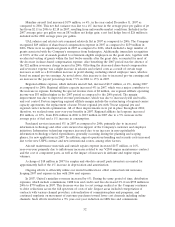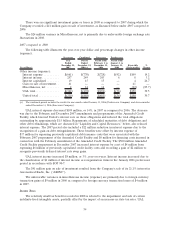United Airlines 2008 Annual Report Download - page 45
Download and view the complete annual report
Please find page 45 of the 2008 United Airlines annual report below. You can navigate through the pages in the report by either clicking on the pages listed below, or by using the keyword search tool below to find specific information within the annual report.agreement is accounted for on a straight-line basis resulting in a ratable accrual of the final $270 million
payment over the lease term.
Legal and Environmental. The Company has certain contingencies resulting from litigation and
claims incident to the ordinary course of business. Management believes, after considering a number of
factors, including (but not limited to) the information currently available, the views of legal counsel, the
nature of contingencies to which the Company is subject and prior experience, that the ultimate
disposition of the litigation and claims will not materially affect the Company’s consolidated financial
position or results of operations. When appropriate, the Company accrues for these matters based on its
assessments of the likely outcomes of their eventual disposition. The amounts of these liabilities could
increase or decrease in the near term, based on revisions to estimates relating to the various claims.
The Company anticipates that if ultimately found liable, its damages from claims arising from the
events of September 11, 2001, could be significant; however, the Company believes that, under the Air
Transportation Safety and System Stabilization Act of 2001, its liability will be limited to its insurance
coverage.
The Company continues to analyze whether any potential liability may result from air cargo/
passenger surcharge cartel investigations following the receipt of a Statement of Objections that the
European Commission (the “Commission”) issued to 26 companies on December 18, 2007. The
Statement of Objections sets out evidence related to the utilization of fuel and security surcharges and
exchange of pricing information that the Commission views as supporting the conclusion that an illegal
price-fixing cartel had been in operation in the air cargo transportation industry. United received a copy
of the Statement of Objections and has provided written and oral responses vigorously disputing the
Commission’s allegations against the Company. Nevertheless, United will continue to cooperate with the
Commission’s ongoing investigation. Based on its evaluation of all information currently available, the
Company has determined that no reserve for potential liability is required and will continue to defend
itself against all allegations that it was aware of or participated in cartel activities. However, penalties for
violation of European competition laws can be substantial and a finding that the Company engaged in
improper activity could have a material adverse impact on our consolidated financial position and results
of operations.
Many aspects of United’s operations are subject to increasingly stringent federal, state and local
laws protecting the environment. Future environmental regulatory developments, such as in regard to
climate change, in the U.S. and abroad could adversely affect operations and increase operating costs in
the airline industry. There are a few climate change laws and regulations that have gone into effect that
apply to United, including environmental taxes for certain international flights, some limited greenhouse
gas reporting requirements and some land-based planning laws which could apply to airports and
ultimately impact airlines depending upon the circumstances. In addition, the EU has adopted legislation
to include aviation within the EU’s existing greenhouse gas emission trading scheme effective in 2012.
There are significant questions that remain as to the legality of applying the scheme to non-EU airlines
and the U.S. and other governments are considering filing a legal challenge to the EU’s unilateral
inclusion of non-EU carriers. While such a measure could significantly increase the costs of carriers
operating in the EU, the precise cost to United is difficult to calculate with certainty due to a number of
variables, and it is not clear whether the scheme will withstand legal challenge. There may be future
regulatory actions taken by the U.S. government, state governments within the U.S., foreign
governments, the International Civil Aviation Organization, or through a new climate change treaty to
regulate the emission of greenhouse gases by the aviation industry. Such future regulatory actions are
uncertain at this time (in terms of either the regulatory requirements or their applicability to United),
but the impact to the Company and its industry would likely be adverse and could be significant,
including the potential for increased fuel costs, carbon taxes or fees, or a requirement to purchase
carbon credits.
See Note 14, “Commitments, Contingent Liabilities and Uncertainties,” in Combined Notes to
Consolidated Financial Statements for further discussion of the above contingencies.
45



